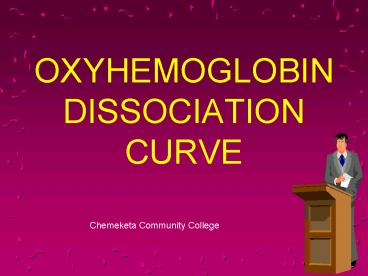OXYHEMOGLOBIN DISSOCIATION CURVE - PowerPoint PPT Presentation
1 / 40
Title:
OXYHEMOGLOBIN DISSOCIATION CURVE
Description:
37 degrees, pH 7.40, PaCO2 40 mm/hg. Deviation causes a shift ... 56 yo woman with ICP elevated. Craniotomy for CVA bleed/ aneurysm ... – PowerPoint PPT presentation
Number of Views:365
Avg rating:3.0/5.0
Title: OXYHEMOGLOBIN DISSOCIATION CURVE
1
OXYHEMOGLOBIN DISSOCIATION CURVE
Chemeketa Community College
2
Oxygen-hemoglobin dissociation curve
3
Oxy/hemo Curve
- The ability of oxygen to bind with and dissociate
from hemoglobin - How shifts change affinity
4
Oxy/hemo Curve
- 97 O2 on Heme of Hgb
- 3 in plasma
- 3 is available in anemia
- Harmful in toxicity
5
Oxy/hemo Curve
- O2 is loosely attached to heme
- Easily formed and dissolved
6
Oxy/hemo Curve
- Heme can carry 4 O2 molecules
- Each site is affected by the other 3
- As they bind, space is decreased
7
(No Transcript)
8
Oxy/hemo Curve
- The more they bind, the harder it becomes to bind
9
Oxy/hemo Curve
- Two transfer sites exist
- Alveolar-capillary site
- Capillary-tissue site
10
O2 Saturation Monitoring
- ABGs, pulse oximetry
- Venous sats
11
O2 Sat. Monitoring
- Does not tell tissue oxygenation
- Patient may have tissue hypoxia in spite of
monitors
12
Oxy/hemo Curve
- Normal curve uses O2 Sats and PaO2 to reflect
amount of oxygen available to the tissues
13
Oxy/hemo Curve-Normals
- 37 degrees, pH 7.40, PaCO2 40 mm/hg
- Deviation causes a shift
14
Oxygen-hemoglobin dissociation curve
15
Oxy/hemo Curve
- Upper-flat portion is lungs
- Steep portion is tissues
- Body can hold 96-97 down to 80 mm/hg
16
Oxy/hemo Curve
- Results of tissue transfer-
- Venous blood at 63
- At 27 mm/hg the Sat is 50
17
Changes in Affinity
- pH, PaCO2, carbon monoxide, abnormal Hgb., temp,
intracellular compounds, 2,3-DPG
18
The Bohr effect
- Oxygenated Hgb stronger acid than deoxygenated
Hgb - Change in pH facilitates release of oxygen
19
The Bohr effect
- Acid becomes weaker
- Blood picks up CO2
- Transports to lungs and process reverses
20
Relationship of hemoglobin sat. and pH
21
Temperature
- Decrease causes increased affinity
- Shift to left
- Increase causes decreased affinity
- Shift to right
22
Relationship of hemoglobin sat. and Temperature
23
2,3 DPG (diphosphoglycerate)
- An enzyme that affects binding directly
- Competes with oxygen
24
2,3 DPG (diphosphoglycerate)
- More 2,3 DPG decreased affinity
- Less increased affinity
25
Carbon Monoxide (CO)
- CO has gt 200 times greater affinity than oxygen
- Always causes lower oxygen sats
26
Abnormal Hemoglobin
- May have greater or lesser affinity
27
Left Shift
- Increased affinity for O2
- At any PaO2, is higher
28
Left Shift
- Easier to hook-on
- Harder to un-hook
29
Left Shift-clinical situations
- Alkalosis, hypocapnia, hypothermia
- Decreased DPG, CO poisoning
- Blood transfusion, fetal Hgb
30
Clinical example
- 56 yo woman with ICP elevated
- Craniotomy for CVA bleed/ aneurysm
- Hyperventilated to vasoconstrict
31
Her ABGs
- pH 7.53, Pa CO2 21 mm/hg
- PO2 118 mm/hg, HCO3 17.8 mEq/L
- O2 Sat 99.1, Temp 37.6
32
What does it mean?
- Left shift makes it hard to un-hook
- Tissue hypoxia must be watched for-even if
readings indicate high sats
33
Right shift
- Decreased affinity for O2
- At any PO2, sat is decreased
- Harder to hook-on
- Easy to un-hook
34
Clinical situations
- Acidosis, hypercapnia, hyperthermia
- Elevated DPG
- Hyperthyroidism, anemia, chronic hypoxia
35
Clinical example
- 25 yo with ARDS
- Secondary to staph pneumonia
- 100 O2, PPV
36
ABGs
- pH 7.27, PaCO2 51.2 mm/hg
- PO2 40 mm/hg, HCO3 23.6 mEq/L
- O2 Sat 76.2, Temp 39.7
37
Clinical example
- Right shift is protective if-additional O2 is
given
38
Summary
- The curve helps us appreciate factors that affect
the oxygenation status of critical patients. - http//www.ventworld.com/resources/oxydisso/oxydis
so.html
39
Summary
- Diseases or treatments shift the curve
- Understanding allows for more appropriate
interventions
40
(No Transcript)

